CREST (LINE), THALWEG (LINE)
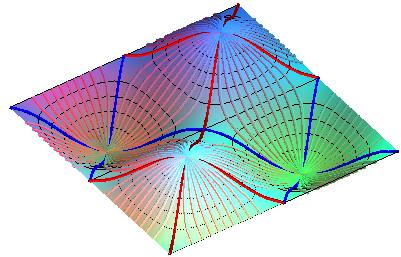
| next curve | previous curve | 2D curves | 3D curves | surfaces | fractals | polyhedra |
CREST (LINE), THALWEG (LINE)

| Talweg is a German word that means: path in the valley.
Synonyms of crest line: ridge line, water divide, dorsal, interfluve. Synonyms of thalweg: talweg, valley line, water drainage line, bottom of the valley. See also the topographic lines and these websites: www.dai.ed.ac.uk/CVonline/LOCAL_COPIES/LOPEZ/node7.html en.wikipedia.org/wiki/Ridge_detection Local Features of smooth Shapes: Ridges and Courses Jan J .Koenderink and Andrea J .van Doorn ETUDE DE LIGNES D'INTERET NATURELLES POUR LA REPRESENTATION D'OBJETS EN VISION PAR ORDINATEUR Ridges in Image and Data Analysis Par David H. Eberly |
| Geographers define the thalweg as the "line joining the
bottommost points of the consecutive transverse sections of a valley";
but what is a transverse section?
The figure opposite shows that the bottommost point of the section by a vertical plane of an inclined gutter is not necessarily at the center of the gutter, intuitive locus of the thalweg (in deep blue); even worse, the slope line (in light blue) passing by the bottommost point is perpendicular to the plane. The orthogonality does not enable us to recognize the thalweg... The transverse section must be perpendicular to the thalweg...
Therefore, to define the transverse section, we must already know the thalweg!
|
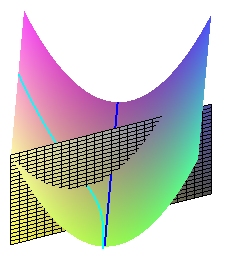 |
Here is a series of definitions that were suggested. We
will see that they all have limitations. When the lines defined below go
through convex regions, they are crest lines, and when they go through
concave regions, they are thalwegs (the points on the surface are said
to be "convex" when the section of the surface by a vertical plane tangent
to the contour line has a maximum of altitude, "concave" when they have
a minimum of altitude). By horizontal reflection, crests and thalwegs are
exchanged.
| First definition (proposed by Jordan
in 1872, used by Dieudonné in Calcul infintésimal for example
and used by topographers of the National Institute of Geographic and Forest
Information (previously IGN)): the crest and thalweg
lines of a surface are the slope lines leading
to a saddle; the crest lines refer to the part going up from the saddle,
the thalweg lines to the part going down.
This definition cannot be defended for at least three reasons: 1: for an unbounded surface like the gutter above, there can be a valley but no saddle! 2: we can always modify the surface locally so that a given slope line would lead to a saddle (or the opposite) and therefore could become a crest line or a thalweg, or not; see also the text by Boussinesq below. 3: a slope line starting from a saddle can very well become asymptotic to another one (see the example opposite): we get a valley with several distinct thalwegs! |
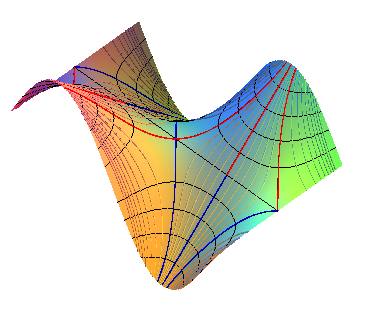 |
Second definition (proposed by de
Saint Venant in 1852, and used for example in the Mathematical dictionary
by F. Le Lionnais and the one by A. Warusfel).
Given a vertical direction, the crest and thalweg lines
are the lines traced on the surface that join the points where the slope
(of the section of the surface by a vertical plane tangent to the slope
line) has a minimum along the corresponding contour line. In
other words, they are the lines of minimum
slant.
This definition would formalize the fact that the thalweg
is less tilted than the neighboring slope lines that meet it (and the crest
line is less tilted that the neighboring slope lines that divert from it).
But this would mean that they would have to be slope lines, which is not the case in general since, in fact, these lines connect the inflection points of the slope lines (in horizontal projection)!
This definition does not allow to detect the crest and
thalweg lines the horizontal projection of which is linear.
|
View of the crests (in red) and the thalwegs (in deep blue) of the surface z = y sin x that would stem from this definition, (along with some slope lines, in light blue); note that the crests and thalwegs that lead to the saddle are lines of maximum slope, and do not correspond to the intuitive crests and thalwegs traced on the right!
|
  |
| Third definition, by the maximal horizontal curvature,
proposed by Gauch in 1993.
Given a vertical direction, the crest and thalweg lines are the lines traced on the surface that join the points where the horizontal curvature of the contour line has a maximum. This definition is motivated by the fact that on topographic maps, the contour lines are, in general, curved at the crests and thalwegs, like opposite. |
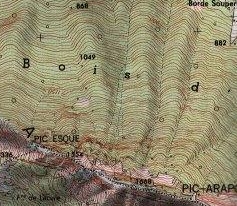 |
| The horizontal curvature, the maximum of which has to
be determined, is equal to: Unfortunately, for the surface z = y – x^4 (U-shaped valley), this definition gives, in addition to the central line, that intuitively corresponds to the geographic thalweg, two parallel lines (that are not slope lines), which would yield 3 thalwegs for one valley! Even worse, for the surface z = y – sqrt(1-x^2), the contour lines of which are arcs of circles, every point is an extremum of curvature, and therefore the thalwegs would cover the whole valley! |
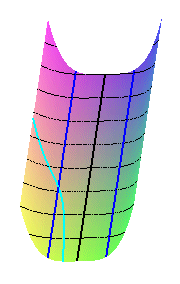 |
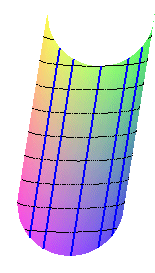 z = y - sqrt(1-x^2): with the 3rd definition, all the points of the valley are thalweg points! |
Fourth definition (proposed by Boussinesq in 1872 - see below, used in part in the mathematical dictionary of F. Le Lionnais)
The crest and thalweg lines are the slope lines for which
the neighbor lines get closer when we travel along them in the direction
of the slope (thalweg), or move away (crests).
Indefensible definition since every slope line of a non planar surface
would be a crest or a thalweg !
Fifth definition (proposed by Rothe
in 1915).
The crest and thalweg lines are the singular slope
lines, in the sense that they correspond to the singular solutions of the
differential equation of the horizontal projections of the slope lines.
| Using the Monge notations, the differential equation
of the slope lines of the surface z = f(x,y) being qdx - pdy = 0, the crest
and thalweg lines are composed of the set of points where u is equal to
zero or undefined, where u is defined by u(qdx - pdy) = dF.
For example for the surface z = y sin x , qdx - pdy= sinx
dx - y cos x dy and
This definition has the defect of not being a geometric definition and not necessarily yields slope lines starting from a saddle... |
 |
Sixth definition:
The thalweg and crest lines are the slope lines that
also are curvature lines of the
surface (lines tangent to a principal direction, where the curvature is
extreme).
It can be proved that these lines correspond to the slope
lines the horizontal projection of which is linear, and were already obtained
through definition #2.
All in all, there only is a consensus about the linearity of the projections of the slope lines!
Examples:
- the crest and thalweg lines of a surface
of revolution with vertical axis are the meridians (if we use the definition
in a large sense; in the strict sense, there aren't any)
- the crest and thalweg lines of a cone
with vertical direction are the generatrices that intersect perpendicularly
the contour lines (for a cone ,
this corresponds to the extrema of f).
| Note of Mr J. Boussinesq presented in 1872 at the Académie
des Sciences.
In a Note dated June 3, 1872 (Comptes rendus, t. LXXIV, P. 1458), Y.
C. Jordan tried to give a geometric definition of the crests and the thalwegs,
lines that everyone recognizes on the surface of the ground and could trace
with little error, but for which we encounter difficulties in determining
the precise nature. Mr Jordan thinks: 1° that these lines cannot be
distinguished, in their trajectory, from the other lines of maximal slope;
2° that their only peculiar nature lies in their starting point, as
the names of crest and thalweg must only be used for the four lines with
maximal slope that come off a saddle, two of them (the crests) going up
from this point, whereas the other two (the thalwegs) go downwards. Allow
me to observe that these two propositions appear to me, for the second
one too restrictive, and for the first one in disagreement with the notion
of crest and thalweg such as they are, in a more or less clear way, in
all minds. Thalwegs and crests can indeed be distinguished among the other
lines of maximal slope, because any inhabitant of the mountains can trace
easily, with the utmost precision, the thalweg of their valley or the crest
that separates the slope they live on and the neighbor slope, with no need
to go to the origin, oftentimes very far and almost inaccessible, of these
lines, or to observe the circumstances, with very little importance, of
the configuration of the ground at this place. Furthermore, if the existence
of these lines depended on the existence of a saddle, then most valleys,
that do not have a saddle at their origin, but the higher part of which
is a sort of amphiteather that lies on the crest of a mountain, would not
have a thalweg, and the various valleys that spread around a summit would
not be separated from one another by any crest line; such consequences
are obviously inadmissible.
To sum up, a crest line is a line whence spread, along all its length, lines of maximal slope that were initially at zero, or imperceptible, distance and that move expand away at noticeable distances; a thalweg is a line on which, at all the points on its length, are reunited, strictly speaking, at least asymptotically, lines of maximal slope that were initially at noticeable distances; such is the characteristic that distinguishes these remarkable lines from the ordinary lines of maximal slope which are, on the contrary, adjacent to their neighbors along all their length.
|
| next curve | previous curve | 2D curves | 3D curves | surfaces | fractals | polyhedra |
© Robert FERRÉOL 2018